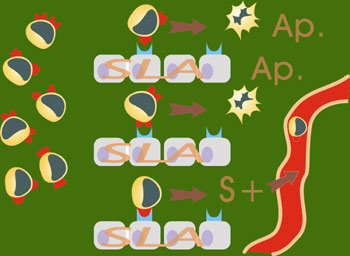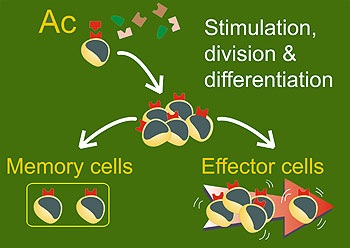| 1.- The capacity to discriminate between its own and foreign components.
The immune system has the extraordinary capacity to discriminate between its own and foreign components, reacting against anything different to it (antigens). The immune system had an extraordinary capacity to react against any molecule different to its own structure however small this may be. However, it does not react against its own components. During the embryonic stage, the lymphocytes that recognize their own molecules are eliminated by a mechanism of apoptosis (programmed cell death). Only the cell clones capable of reacting against antigens pass into the circulatory system, whenever they are associated to the SLA itself, as well as clones tolerant to their own structures. Histocompatibility antigens (SLA) play a key role in this selection. |

In the thymus, lymphocytes are selected in such a way that they can only react against molecules foreign to the organism (positive selection, S+). Only these lymphocytes go into the bloodstream. On the other hand cellular destruction (apoptosis, Ap) of the lymphocytes that could react against the structure itself takes place.
|
|
Occasionally, errors occur in the immune system when distinguishing between the body’s own and foreign components. Therefore, it could occur that the immune system does not respond to a foreign particle. This phenomenon is known as tolerance. On the other hand, in some circumstances the immune system reacts against its own structures. These reactions are known as autoimmunity. |
|
2.- Specificity of the immune system is due to the fact that both antibodies and lymphocytes only recognize one epitope or antigenic determinant. The immune system can recognize thousands of millions of different antigens, but a specific lymphocyte will be induced for each determinant. There are as many lymphocytes stimulated as there are determinants making up the antigen. |
| 
Specific recognition of a single antigenic determinant (one determinant=one cell). After recognition, a proliferation of cells takes place. Because of this some lymphocytes become memory lymphocytes and others will act as effector cells. | 3. Memory.
When an antigen is presented for the first time, the immune system produces a primary response, leaving one memory lymphocyte for each of the epitopes of the antigen. The next time this antigen comes into contact with the immune system (secondary response), the memory lymphocyte is stimulated into production of however many clones of specific lymphocytes that may be needed against certain epitopes. This is faster and more effective than the primary response. | | |

